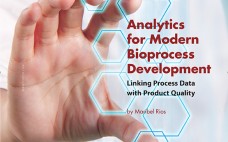Antibody-purity analysis is critical to successful development of monoclonal antibody (MAb) biopharmaceuticals. Their manufacture involves processes of protein purification, formulation, and stability evaluation. All those processes need highly accurate and reproducible analytical results to support decisions made by product developers and manufacturers. A common technology for antibody-purity analysis is sodium-dodecyl sulfate polyacrylamide gel electrophoresis (SDS-PAGE). In this technique, a polypeptide chain binds SDS proportionally to its relative molecular mass. The detergent nature of SDS denatures proteins by disrupting their noncovalent…
2014
Accelerating Purification Process Development of an Early Phase MAb with High-Throughput Automation
Purification process development of monoclonal antibodies (MAbs) has traditionally relied on a strategic trial-and-error approach using small-scale preparative chromatography for determining the operational parameters that would be optimal for clinical manufacturing. Doing so is demanding of both time and resources, and it thus restricts the number of early phase therapeutic drug molecules that can be evaluated in a company's development pipeline toward clinical trials. With high-throughput (HT) technologies incorporated at key points in development and laboratory operations, an operating space…
Stopping Biological Clocks
The only method of stable and long-term — practically infinite — preservation and storage of perishable biological materials (biostabilization) is to keep them in a glassy (vitreous) state. This was understood by Father Luyet when he titled his pioneering works in the 1930s, “The Vitrification of Organic Colloids and of Protoplasm” and “Revival of Frog's Spermatozoa Vitrified in Liquid Air” (1,2). He and other pioneers of the cryobiological frontiers clearly understood that only a glassy state would ensure stable and…
Microbial Strain Development Using BioLayer Interferometry
At the core of every drug development program is the challenge to successfully express active and high-quality proteins. Drug developers often are faced with protein-expression issues, struggling to express a specific protein for months (and sometimes years) with varying degrees of success. Low or no expression, insoluble expression, and proteolytic clipping of an expressed protein or a combination thereof are examples of the hurdles encountered in product development efforts. With protein expression being vital to the success of every stage…
Begin By Thinking of Your Goal
The biopharmaceutical industry is experiencing a surge of collaborations among large and small companies seeking to develop new drug candidates. Often, such efforts have been a result of a merger or acquisition. But other factors also are pushing the rise in collaborations, including dwindling drug pipelines, increasing generics and biosimilars, rising costs of drug development, and changing regulations that are already complex. High costs of drug development in particular have created greater risks. That is especially true for small biotechnology…
Single-Use Author Insights – April Supplement
April 2014 Issue Author Insights
Analytics for Modern Bioprocess Development
Twelve years ago, about the same time the US Food and Drug Administration was putting the finishing touches on its quality by design (QbD) and process analytical technology (PAT) guidelines, I wrote an article about breakthrough pharmaceutical educational programs. That article included the perspectives from a few members in academia of the future essential skills for pharmaceutical students. At the time, bioinformatics and computerized industrial process modeling were relatively new disciplines, but their importance in future manufacturing was clear. Several…
Advocating for Advanced Therapies
My sense is that we’ve come a long way and that 2013 was actually a very good year — perhaps maybe even the best year ever for regenerative medicines and advanced therapies. Clearly the financial markets have allowed us to do more in terms of raising capital to fund projects in this space, and we are seeing a growing interest in the sector in the investor community. We’ve seen a number of major financing events over the course of the…
Cell Therapy Will Transform the Future of Medicine
The third annual IBC Cell Therapy Bioprocessing conference was held in Bethesda, MD, on 21–22 October 2013. It brought pioneers in the development of cell-based therapies together with companies that have enabling technologies, such as bioreactors, cell culture media, and advanced monitoring software. After the conference, I discussed the highlights and key themes coming out of the event with Dr. Phil Vanek, general manager of cell bioprocessing at GE Healthcare Life Sciences in Westborough, MA. Also an instructor for advanced…

